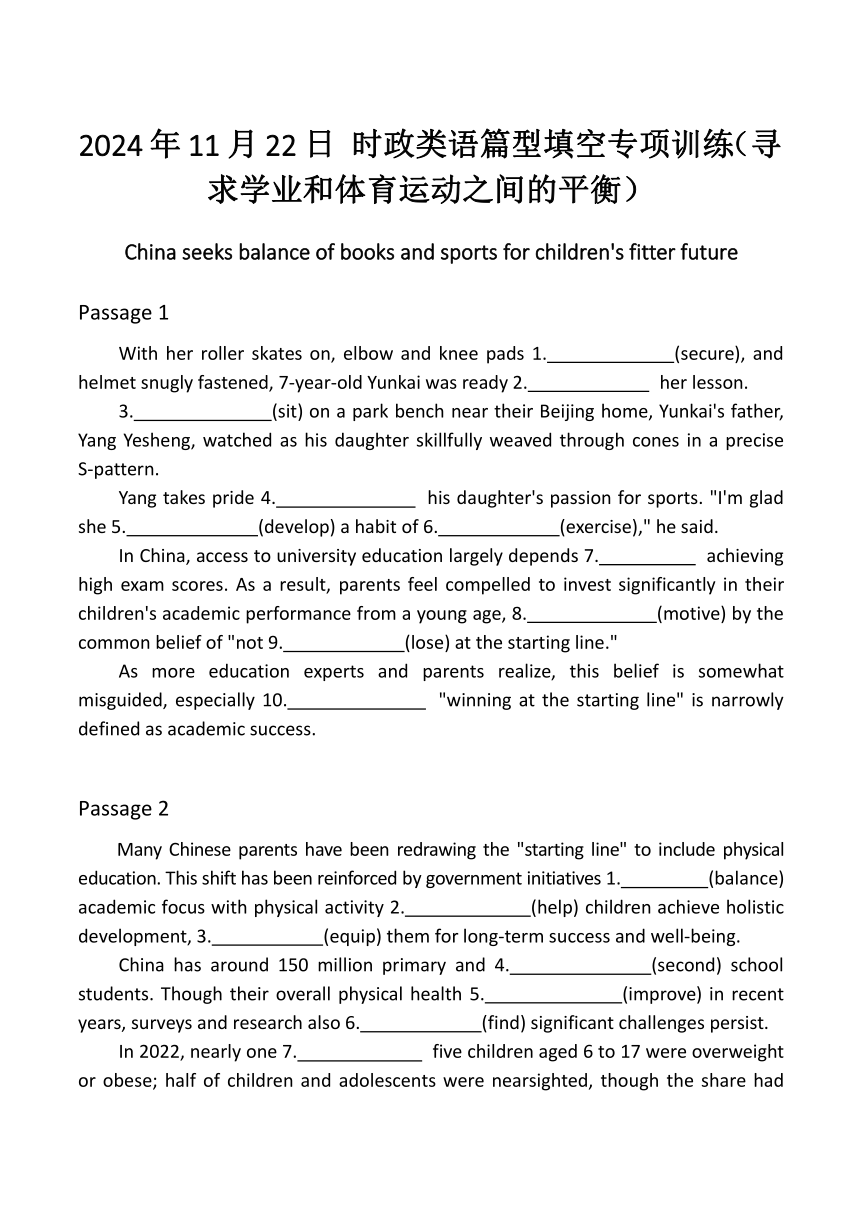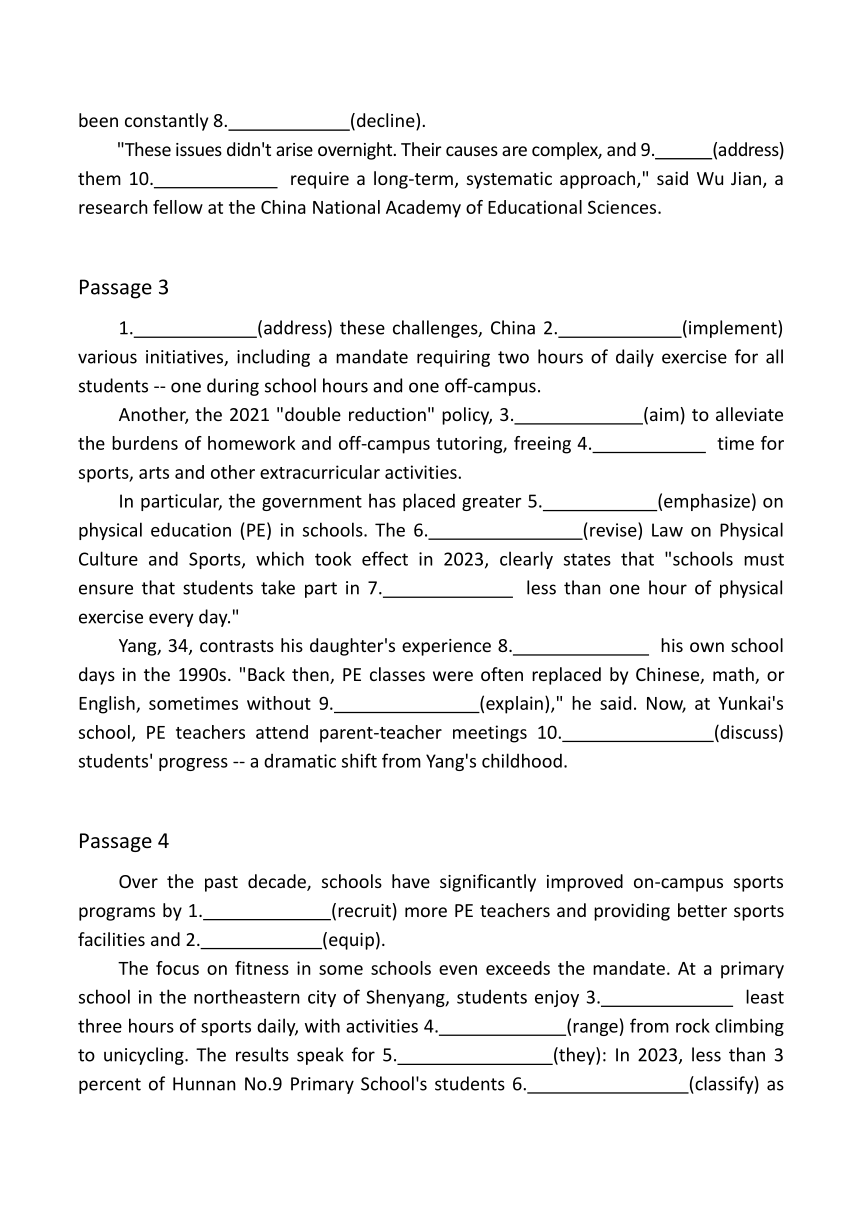2024年11月22日 时政类语篇型填空专项训练(寻求学业和体育运动之间的平衡)(4篇,含答案与译文)-2025届高三英语复习
文档属性
| 名称 | 2024年11月22日 时政类语篇型填空专项训练(寻求学业和体育运动之间的平衡)(4篇,含答案与译文)-2025届高三英语复习 |  | |
| 格式 | docx | ||
| 文件大小 | 28.9KB | ||
| 资源类型 | 教案 | ||
| 版本资源 | 人教版(2019) | ||
| 科目 | 英语 | ||
| 更新时间 | 2025-01-24 17:05:06 | ||
图片预览


文档简介
2024年11月22日 时政类语篇型填空专项训练(寻求学业和体育运动之间的平衡)
China seeks balance of books and sports for children's fitter future
Passage 1
With her roller skates on, elbow and knee pads 1. (secure), and helmet snugly fastened, 7-year-old Yunkai was ready 2. her lesson.
3. (sit) on a park bench near their Beijing home, Yunkai's father, Yang Yesheng, watched as his daughter skillfully weaved through cones in a precise S-pattern.
Yang takes pride 4. his daughter's passion for sports. "I'm glad she 5. (develop) a habit of 6. (exercise)," he said.
In China, access to university education largely depends 7. achieving high exam scores. As a result, parents feel compelled to invest significantly in their children's academic performance from a young age, 8. (motive) by the common belief of "not 9. (lose) at the starting line."
As more education experts and parents realize, this belief is somewhat misguided, especially 10. "winning at the starting line" is narrowly defined as academic success.
Passage 2
Many Chinese parents have been redrawing the "starting line" to include physical education. This shift has been reinforced by government initiatives 1. (balance) academic focus with physical activity 2. (help) children achieve holistic development, 3. (equip) them for long-term success and well-being.
China has around 150 million primary and 4. (second) school students. Though their overall physical health 5. (improve) in recent years, surveys and research also 6. (find) significant challenges persist.
In 2022, nearly one 7. five children aged 6 to 17 were overweight or obese; half of children and adolescents were nearsighted, though the share had been constantly 8. (decline).
"These issues didn't arise overnight. Their causes are complex, and 9. (address) them 10. require a long-term, systematic approach," said Wu Jian, a research fellow at the China National Academy of Educational Sciences.
Passage 3
1. (address) these challenges, China 2. (implement) various initiatives, including a mandate requiring two hours of daily exercise for all students -- one during school hours and one off-campus.
Another, the 2021 "double reduction" policy, 3. (aim) to alleviate the burdens of homework and off-campus tutoring, freeing 4. time for sports, arts and other extracurricular activities.
In particular, the government has placed greater 5. (emphasize) on physical education (PE) in schools. The 6. (revise) Law on Physical Culture and Sports, which took effect in 2023, clearly states that "schools must ensure that students take part in 7. less than one hour of physical exercise every day."
Yang, 34, contrasts his daughter's experience 8. his own school days in the 1990s. "Back then, PE classes were often replaced by Chinese, math, or English, sometimes without 9. (explain)," he said. Now, at Yunkai's school, PE teachers attend parent-teacher meetings 10. (discuss) students' progress -- a dramatic shift from Yang's childhood.
Passage 4
Over the past decade, schools have significantly improved on-campus sports programs by 1. (recruit) more PE teachers and providing better sports facilities and 2. (equip).
The focus on fitness in some schools even exceeds the mandate. At a primary school in the northeastern city of Shenyang, students enjoy 3. least three hours of sports daily, with activities 4. (range) from rock climbing to unicycling. The results speak for 5. (they): In 2023, less than 3 percent of Hunnan No.9 Primary School's students 6. (classify) as obese, and just 13.8 percent were myopic, far below national averages.
"Each activity 7. (choose) for its specific benefits," said Hou Mingfei, the school's principal. "Rock climbing, for example, helps with scoliosis, while unicycling improves coordination of the body and mind."
Education 8. (special) have encouraged parents, 9. cooperation with schools, to help children explore their interests and guide them toward a sport they love, as interests help build 10. (last) fitness habits.
参考答案
参考答案1
1.secured 2.for 3.Sitting 4.in 5.has developed
6.exercising 7.on 8.motivated 9.losing 10.when
参考译文1
穿上旱冰鞋,戴上护肘和护膝,戴上头盔,7岁的云凯已经准备好上课了。
坐在他们北京家附近公园的长椅上,云凯的父亲杨业生(音译)看着他的女儿熟练地编织出精确的s型圆锥体。
杨为女儿对体育的热情感到自豪。“我很高兴她养成了锻炼的习惯,”他说。
在中国,能否接受大学教育在很大程度上取决于考试成绩。因此,出于“不要输在起跑线上”的共同信念,父母不得不在孩子很小的时候就为他们的学习成绩投入大量资金。
越来越多的教育专家和家长意识到,这种信念在某种程度上是被误导的,尤其是当“赢在起跑线上”被狭隘地定义为学业成功时。
参考答案2
1.balancing 2.to help 3.equipping 4.secondary 5.has improved
6.found 7.in 8.declining 9.addressing 10.will
参考译文2
许多中国家长一直在重新划定“起跑线”,将体育教育纳入其中。这一转变得到了政府平衡学业和体育活动的倡议的加强,以帮助儿童实现全面发展,为他们的长期成功和幸福做好准备。
中国有大约1.5亿中小学生。尽管近年来他们的整体身体健康状况有所改善,但调查和研究也发现,重大挑战依然存在。
2022年,近五分之一的6至17岁儿童超重或肥胖;一半的儿童和青少年患有近视,尽管这一比例一直在下降。
“这些问题不是一夜之间出现的。其原因是复杂的,解决这些问题需要一个长期的、系统的方法,”中国教育科学研究院研究员吴健说。
参考答案3
1.To address 2.has implemented 3.aimed 4.up 5.emphasis
6.revised 7.no 8.with 9.explanation 10.to discuss
参考译文3
为了应对这些挑战,中国实施了各种举措,包括要求所有学生每天锻炼两个小时——一个在上课时间,一个在校外。
另一项是2021年的“双减”政策,旨在减轻家庭作业和校外辅导的负担,腾出时间进行体育、艺术和其他课外活动。
特别是,政府更加重视学校的体育教育(PE)。修订后的《体育法》于2023年生效,明确规定“学校必须确保学生每天参加不少于一个小时的体育锻炼。”
34岁的杨将女儿的经历与自己上世纪90年代的学生时代进行了对比。他说:“那时候,体育课经常被语文、数学或英语取代,有时没有任何解释。”现在,在云凯的学校,体育老师参加家长会,讨论学生的进步——这与杨的童年时代发生了巨大的变化。
参考答案4
1.recruiting 2.equipment 3.at 4.ranging 5.themselves
6.were classified 7.is chosen 8.specialists 9.in 10.lasting
参考译文4
在过去的十年里,学校通过招聘更多的体育教师和提供更好的体育设施和设备,大大改善了校园体育项目。
一些学校对健身的关注甚至超过了规定。在东北城市沈阳的一所小学,学生们每天至少有三个小时的体育活动,从攀岩到骑独轮车都有。调查结果不言自明:2023年,湘南九小不到3%的学生被归为肥胖,只有13.8%的学生近视,远低于全国平均水平。
学校校长侯明飞说:“每项活动都是根据其特定的好处来选择的。”“例如,攀岩有助于治疗脊柱侧凸,而骑独轮车可以改善身心的协调。”
教育专家鼓励家长与学校合作,帮助孩子探索自己的兴趣,引导他们从事自己喜欢的运动,因为兴趣有助于培养持久的健身习惯。
China seeks balance of books and sports for children's fitter future
Passage 1
With her roller skates on, elbow and knee pads 1. (secure), and helmet snugly fastened, 7-year-old Yunkai was ready 2. her lesson.
3. (sit) on a park bench near their Beijing home, Yunkai's father, Yang Yesheng, watched as his daughter skillfully weaved through cones in a precise S-pattern.
Yang takes pride 4. his daughter's passion for sports. "I'm glad she 5. (develop) a habit of 6. (exercise)," he said.
In China, access to university education largely depends 7. achieving high exam scores. As a result, parents feel compelled to invest significantly in their children's academic performance from a young age, 8. (motive) by the common belief of "not 9. (lose) at the starting line."
As more education experts and parents realize, this belief is somewhat misguided, especially 10. "winning at the starting line" is narrowly defined as academic success.
Passage 2
Many Chinese parents have been redrawing the "starting line" to include physical education. This shift has been reinforced by government initiatives 1. (balance) academic focus with physical activity 2. (help) children achieve holistic development, 3. (equip) them for long-term success and well-being.
China has around 150 million primary and 4. (second) school students. Though their overall physical health 5. (improve) in recent years, surveys and research also 6. (find) significant challenges persist.
In 2022, nearly one 7. five children aged 6 to 17 were overweight or obese; half of children and adolescents were nearsighted, though the share had been constantly 8. (decline).
"These issues didn't arise overnight. Their causes are complex, and 9. (address) them 10. require a long-term, systematic approach," said Wu Jian, a research fellow at the China National Academy of Educational Sciences.
Passage 3
1. (address) these challenges, China 2. (implement) various initiatives, including a mandate requiring two hours of daily exercise for all students -- one during school hours and one off-campus.
Another, the 2021 "double reduction" policy, 3. (aim) to alleviate the burdens of homework and off-campus tutoring, freeing 4. time for sports, arts and other extracurricular activities.
In particular, the government has placed greater 5. (emphasize) on physical education (PE) in schools. The 6. (revise) Law on Physical Culture and Sports, which took effect in 2023, clearly states that "schools must ensure that students take part in 7. less than one hour of physical exercise every day."
Yang, 34, contrasts his daughter's experience 8. his own school days in the 1990s. "Back then, PE classes were often replaced by Chinese, math, or English, sometimes without 9. (explain)," he said. Now, at Yunkai's school, PE teachers attend parent-teacher meetings 10. (discuss) students' progress -- a dramatic shift from Yang's childhood.
Passage 4
Over the past decade, schools have significantly improved on-campus sports programs by 1. (recruit) more PE teachers and providing better sports facilities and 2. (equip).
The focus on fitness in some schools even exceeds the mandate. At a primary school in the northeastern city of Shenyang, students enjoy 3. least three hours of sports daily, with activities 4. (range) from rock climbing to unicycling. The results speak for 5. (they): In 2023, less than 3 percent of Hunnan No.9 Primary School's students 6. (classify) as obese, and just 13.8 percent were myopic, far below national averages.
"Each activity 7. (choose) for its specific benefits," said Hou Mingfei, the school's principal. "Rock climbing, for example, helps with scoliosis, while unicycling improves coordination of the body and mind."
Education 8. (special) have encouraged parents, 9. cooperation with schools, to help children explore their interests and guide them toward a sport they love, as interests help build 10. (last) fitness habits.
参考答案
参考答案1
1.secured 2.for 3.Sitting 4.in 5.has developed
6.exercising 7.on 8.motivated 9.losing 10.when
参考译文1
穿上旱冰鞋,戴上护肘和护膝,戴上头盔,7岁的云凯已经准备好上课了。
坐在他们北京家附近公园的长椅上,云凯的父亲杨业生(音译)看着他的女儿熟练地编织出精确的s型圆锥体。
杨为女儿对体育的热情感到自豪。“我很高兴她养成了锻炼的习惯,”他说。
在中国,能否接受大学教育在很大程度上取决于考试成绩。因此,出于“不要输在起跑线上”的共同信念,父母不得不在孩子很小的时候就为他们的学习成绩投入大量资金。
越来越多的教育专家和家长意识到,这种信念在某种程度上是被误导的,尤其是当“赢在起跑线上”被狭隘地定义为学业成功时。
参考答案2
1.balancing 2.to help 3.equipping 4.secondary 5.has improved
6.found 7.in 8.declining 9.addressing 10.will
参考译文2
许多中国家长一直在重新划定“起跑线”,将体育教育纳入其中。这一转变得到了政府平衡学业和体育活动的倡议的加强,以帮助儿童实现全面发展,为他们的长期成功和幸福做好准备。
中国有大约1.5亿中小学生。尽管近年来他们的整体身体健康状况有所改善,但调查和研究也发现,重大挑战依然存在。
2022年,近五分之一的6至17岁儿童超重或肥胖;一半的儿童和青少年患有近视,尽管这一比例一直在下降。
“这些问题不是一夜之间出现的。其原因是复杂的,解决这些问题需要一个长期的、系统的方法,”中国教育科学研究院研究员吴健说。
参考答案3
1.To address 2.has implemented 3.aimed 4.up 5.emphasis
6.revised 7.no 8.with 9.explanation 10.to discuss
参考译文3
为了应对这些挑战,中国实施了各种举措,包括要求所有学生每天锻炼两个小时——一个在上课时间,一个在校外。
另一项是2021年的“双减”政策,旨在减轻家庭作业和校外辅导的负担,腾出时间进行体育、艺术和其他课外活动。
特别是,政府更加重视学校的体育教育(PE)。修订后的《体育法》于2023年生效,明确规定“学校必须确保学生每天参加不少于一个小时的体育锻炼。”
34岁的杨将女儿的经历与自己上世纪90年代的学生时代进行了对比。他说:“那时候,体育课经常被语文、数学或英语取代,有时没有任何解释。”现在,在云凯的学校,体育老师参加家长会,讨论学生的进步——这与杨的童年时代发生了巨大的变化。
参考答案4
1.recruiting 2.equipment 3.at 4.ranging 5.themselves
6.were classified 7.is chosen 8.specialists 9.in 10.lasting
参考译文4
在过去的十年里,学校通过招聘更多的体育教师和提供更好的体育设施和设备,大大改善了校园体育项目。
一些学校对健身的关注甚至超过了规定。在东北城市沈阳的一所小学,学生们每天至少有三个小时的体育活动,从攀岩到骑独轮车都有。调查结果不言自明:2023年,湘南九小不到3%的学生被归为肥胖,只有13.8%的学生近视,远低于全国平均水平。
学校校长侯明飞说:“每项活动都是根据其特定的好处来选择的。”“例如,攀岩有助于治疗脊柱侧凸,而骑独轮车可以改善身心的协调。”
教育专家鼓励家长与学校合作,帮助孩子探索自己的兴趣,引导他们从事自己喜欢的运动,因为兴趣有助于培养持久的健身习惯。
